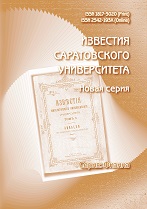|
Solid-State Electronics, Micro and Nanoelectronics
Influence of functional groups on the electronic and energy characteristics of thin films of holey graphene: Results of DFTB simulation
P. V. Barkova, M. M. Slepchenkova, O. E. Glukhovaab
a Saratov State University
b I. M. Sechenov First Moscow State Medical University
Abstract:
Background and Objectives: Graphene and its derivatives are promising materials for the fabrication of biosensors with high sensitivity and low detection limits due to their large specific surface area, excellent flexibility and strength, and high electrical conductivity. This work examines holey graphene, which has been successfully synthesized and has already found its application in nano- and bioelectronics. It is known from experimental data that the free edges of holes in the structure of holey graphene contain functional groups, the influence of which should be taken into account when developing sensor devices based on it. The purpose of this work was to establish the patterns of the influence of functionalization with carbonyl and carboxyl groups on the electronic energy parameters of holey graphene. Materials and Methods: The object of study was a film of holey graphene with almost circular holes with a diameter of 1.2 nm. All calculations were performed using the self-consistent-charge density functional based tight binding method in the DFTB+ software package at a temperature of 300 K. The process of functionalization of holey graphene was modeled using an original algorithm for step-by-step placement of functional groups on atoms at the edges of the hole. Results: Based on the calculation results, we have revealed the patterns of redistribution of the electron charge density between functional groups and holey graphene and the features of changes in the Fermi level of a graphene object during functionalization. Conclusion: The revealed patterns are important in the development of sensitive elements of sensor devices made on the basis of holey graphene.
Keywords:
holey graphene, functionalization, carbonyl and carboxyl groups, formation energy, partial charge, density functional based tight binding method.
Received: 19.12.2023
Citation:
P. V. Barkov, M. M. Slepchenkov, O. E. Glukhova, “Influence of functional groups on the electronic and energy characteristics of thin films of holey graphene: Results of DFTB simulation”, Izv. Sarat. Univ. Physics, 24:2 (2024), 114–125
Linking options:
https://www.mathnet.ru/eng/isuph515 https://www.mathnet.ru/eng/isuph/v24/i2/p114
|

| Statistics & downloads: |
| Abstract page: | 76 | | Full-text PDF : | 12 | | References: | 14 |
|




 Contact us:
Contact us: Terms of Use
Terms of Use
 Registration to the website
Registration to the website Logotypes
Logotypes









 Citation in format
Citation in format 